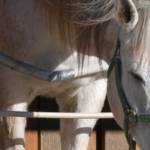Hoof Health: Laminitis Prediction Test?

If you suspect your horse has an endocrine disorder, your veterinarian may offer multiple tests to achieve a diagnosis. Tests can be as simple as a single blood sample to measure individual molecules such as insulin or glucose, or tests may involve transport to a referral facility, intravenous catheters, and multiple sample collections. One research group* believes an oral glucose test (OGT) may predict the occurrence of laminitis secondary to hormonal imbalances such as pituitary pars intermedia dysfunction (PPID).
“Laminitis remains a critical condition of the equine foot, with multiple causes and limited curative therapies,” said Kathleen Crandell, Ph.D., a nutritionist for Kentucky Equine Research (KER).
Insulin dysregulation and PPID, which occur increasingly in domestic horses, frequently result in laminitis, a painful separation of the horse’s hoof wall from the internal structures of the foot.
“Studies show a strong link between insulin dysregulation, hyperinsulinemia (elevated insulin levels circulating in the bloodstream), and laminitis as insulin infusion can induce laminitis in healthy horses and ponies in laboratory settings,” noted Crandell. “Feedstuffs high in nonstructural carbohydrates (NSC), such as certain pastures and high-starch concentrates, may stimulate hyperinsulinemia and trigger laminitis in horses with insulin dysregulation.”
In their study, Meier and colleagues performed an OGT on 37 ponies free from laminitis. Ponies with elevated insulin levels following the OGT (22-1,133 mIU/mL) underwent a diet challenge period (DCP) that involved being fed diets high in NSC (12 g NSC/kg body weight/day for up to 18 days). This study revealed:
- Over one-third of the ponies developed Obel grade 1 or 2 laminitis during the challenge;
- Ponies with higher blood glucose and insulin levels during the diet challenge developed laminitis more frequently;
- Development of laminitis was also associated with elevated insulin concentrations measured during the OGT. Specifically, laminitis occurred at frequencies of 0% when insulin was <50 mIU/mL following the OGT; 35% if insulin was 50-195 mIU/mL; and 86% if insulin was >195 mIU/mL.
“In summary, the occurrence of laminitis was associated with higher glucose and insulin responses to both the OGT and challenge diet. This finding suggests that the frequency of laminitis can be predicted based on insulin and glucose hyperresponsiveness to both of these oral carbohydrate challenges,” Crandell explained.
According to the researchers, these tests could also “assist clinicians in assessing the value and significance of OGT results in terms of immediate laminitis risk.”
To minimize the development of laminitis in horses and ponies, consider these nutrition-related suggestions:
- Maintain an appropriate body weight throughout all seasons. Keep horses and ponies between 4 and 6 on the standard body condition score system.
- Keep the total diet at or below 10-12% nonstructural carbohydrates in susceptible individuals. This typically involves having hay analyzed and possibly soaking hay to remove sugar.
Supplement diets with hoof-healthy nutrients like those found in Bio-Bloom PS (Bio-Bloom HF in Australia), a nutritional supplement containing the key nutrients for hoof health. Biotin, methionine, iodine, and chelated zinc can help improve hoof growth and strength.
*Meier, A.D., M.A. de Laat, D.B. Reiche, et al. 2017. The oral glucose test predicts laminitis risk in ponies fed a diet high in nonstructural carbohydrates. Domestic Animal Endocrinology. 63:1-9.








